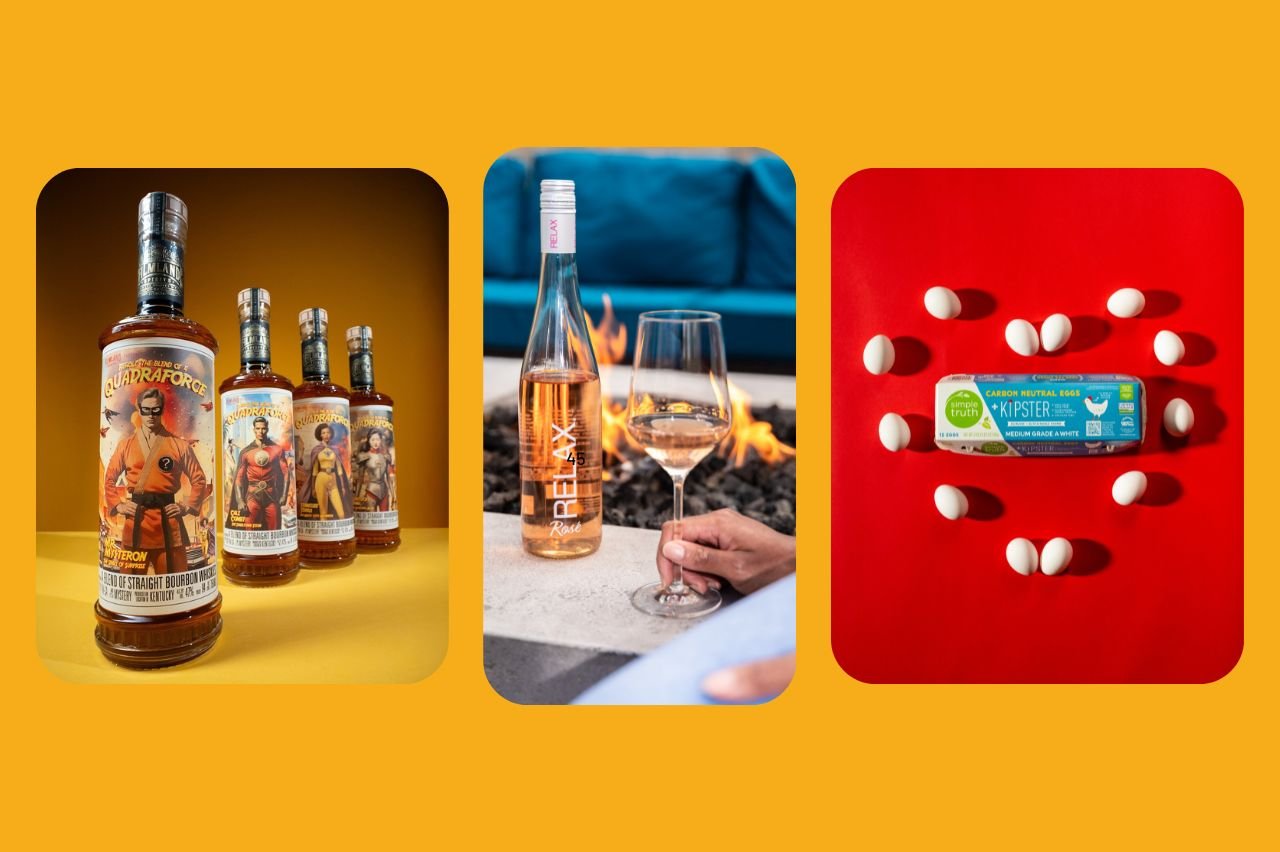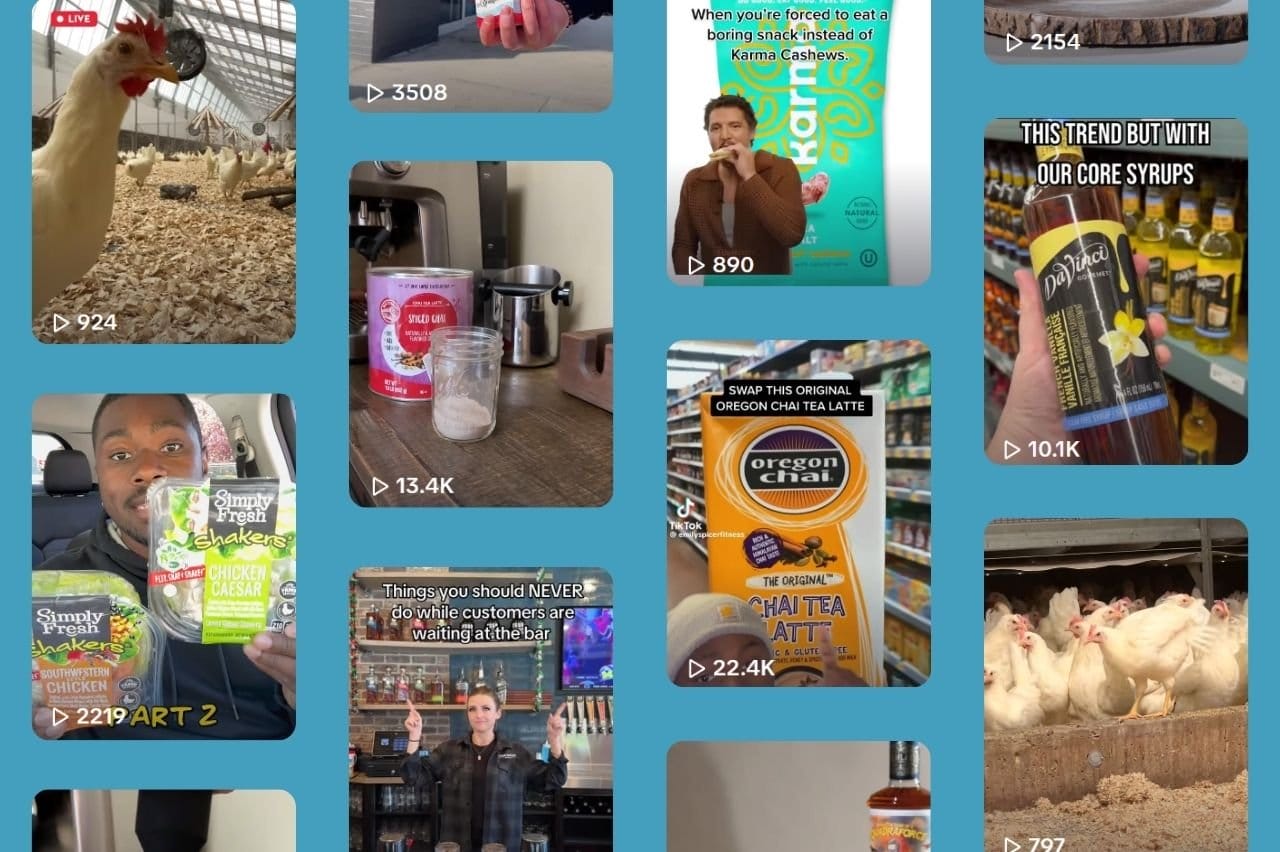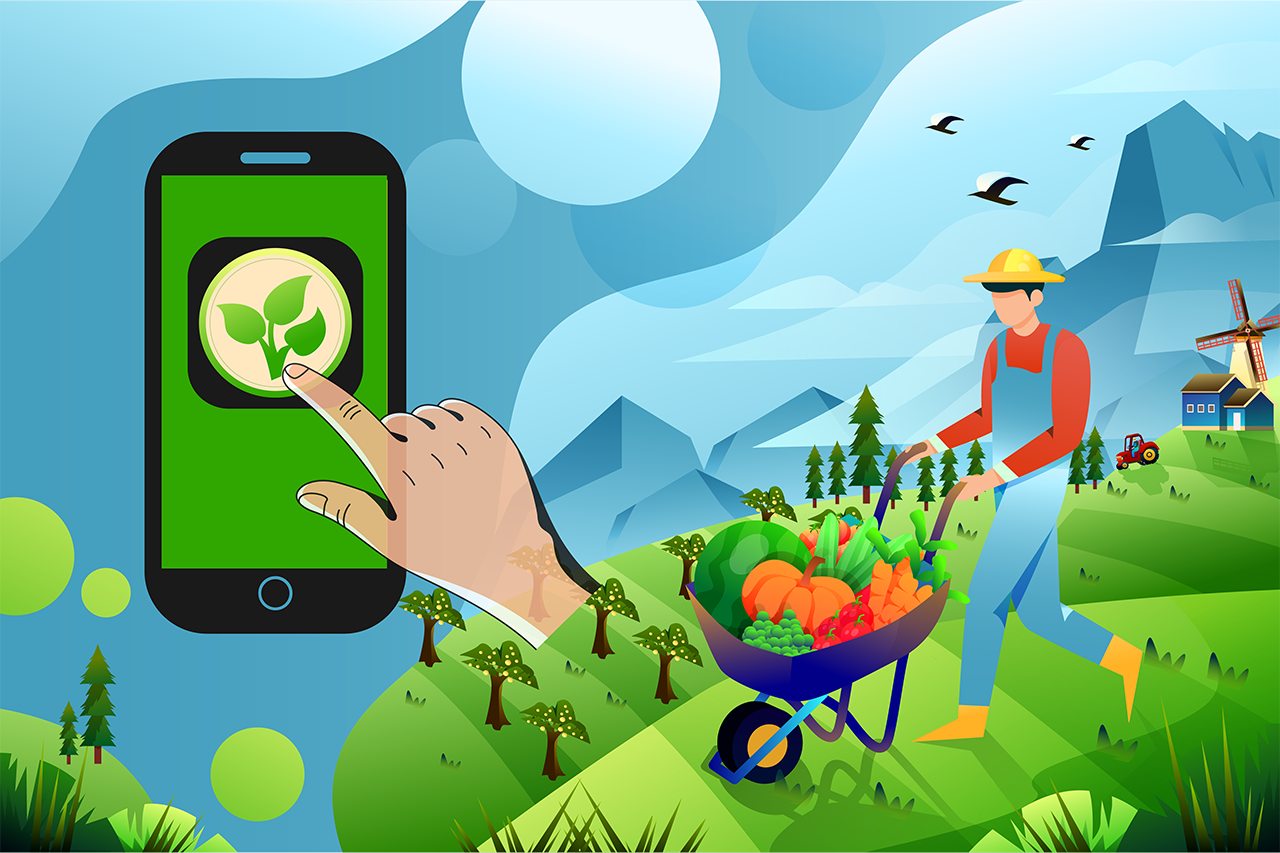The CPG Social Media Visual Guide: Food Photography Standards By Platform in 2025

The Visual Renaissance No Brand Can Ignore
It’s tough to scroll past a perfectly styled food photo on Instagram, Pinterest or Facebook.
They’re delicious.
The social media landscape for CPG food brands has undergone a dramatic transformation.
What once worked universally across platforms now requires precision-engineered visual content tailored to each platform’s unique algorithm, audience expectations, and consumption patterns.
It’s happening everywhere.
- That artisanal ice cream brand killing it on Instagram is flopping on TikTok.
- The snack company with millions of Pinterest saves can’t seem to gain traction on Threads.
- These aren’t isolated challenges – we’re witnessing a fundamental shift in how food photography performs across the digital ecosystem.
The evolution of platform-specific visual standards tells the story better than any marketing report could: consumers aren’t rejecting food content—they’re demanding that it adapt to their platform-specific expectations.
But is it just about being “platform-centric”… or actually better?
With AI-enhanced editing tools, hyper-specific audience targeting, and increasingly sophisticated analytics, brands are doing more than capturing fleeting attention—they’re redefining what successful food photography looks like in 2025.
And the algorithms are rewarding them.
Major food conglomerates have restructured their creative departments with platform-specific teams, and midsize CPG brands are seeing engagement rates soar with tailored visual strategies.
Not All Channels Are Made Equal
It’s clear: cross-platform visual strategy is essential—but increasingly complex. Not every brand can execute effectively across all channels.
The explosion of platform-specific optimization has created what some are calling “visual fragmentation.” With so many unique requirements across platforms—often requiring completely different shooting styles, aspect ratios, and post-production techniques—it’s becoming nearly impossible for brands to maintain visual consistency while maximizing performance.
While adaptation is necessary, the category risks visual identity dilution, where only the most strategic, well-resourced, and adaptable brands will thrive long-term.
Nevertheless, performance data consistently shows that platform-optimized food photography doesn’t just generate more engagement—it drives measurable conversion, with consumers increasingly making purchase decisions based on how authentically and appetizingly products are presented in their preferred social spaces.
“Is food photography becoming more authentic, or just differently produced?”
Still, how do we explain consumers who scroll past professional studio shots to engage with seemingly amateur content—then become frustrated when products don’t match their expectations?
It all points to today’s complex visual paradox. Consumers demand authenticity, aspiration, realism and perfection… All at the same time.
Understanding Platform-Specific Visual Requirements in 2025
Each major social platform has evolved distinct visual preferences, driven by their unique user behaviors, technical specifications, and algorithmic priorities:
- 78% of consumers report platform-specific expectations for food content
- 67% are more likely to engage with visuals optimized for the platform they’re using
- 52% of consumers report feeling less engaged when they know content is AI-generated or non-native
- 43% follow brands specifically for their platform-appropriate visual content
- Visual consistency across platforms is now secondary to platform-specific performance
But here’s where it gets interesting – are these standards actually about quality, or about manufacturing specific types of authenticity?
Consider this: Each platform has cultivated its own visual language and aesthetic expectations. Content that feels “real” on TikTok might appear overly casual on LinkedIn, while Instagram’s polished aesthetic would seem inauthentic on BeReal.
Everyone’s less likely to engage with content that feels out of place.
Studies show that platform-appropriate visuals receive 2.8x more engagement than generically high-quality content. Could the underperformance of traditional food photography be largely attributed to its failure to adapt to platform-specific visual languages?
So maybe food photography’s evolution isn’t just about technical quality—it’s about cultural context.
That said, when consumers do engage with food content, research indicates that 63% remain loyal to brands that consistently deliver platform-appropriate visuals. That’s not just engagement—it’s a fundamental shift in how food photography must be conceived, produced, and distributed.
The Platform-Specific Food Photography Playbook
Instagram: Curated Perfection with Authentic Touches
In 2025, Instagram remains the platform where artistic food photography thrives, but with evolving standards:
Visual Specifications:
- Primary Feed: 1:1 square and 4:5 vertical formats dominate
- Stories: Full bleed 9:16 with interactive elements
- Reels: 9:16 with high motion content
- Carousel: Multiple images with progressive storytelling
- Lighting: Bright, clean lighting with defined shadows
- Color: Rich, saturated colors with consistent brand filters
Content Approach:
- “Perfect imperfection” that balances aspirational styling with authentic touches
- Hero shots that showcase products in idealized but achievable settings
- Behind-the-scenes content that reveals thoughtful production
- Ingredient-forward imagery highlighting quality and sourcing
- Meticulous plating with strategically “casual” elements
One premium condiment brand recently increased engagement by 47% by maintaining their high-production hero shots but adding subtle, deliberately imperfect elements – a drip of sauce, slightly asymmetrical plating, or visible texture variations. The comments section filled with consumers noting how “real” and “appetizing” the food looked.
“Platform-appropriate food photography isn’t about quality reduction; it’s about contextual authenticity.”
TikTok: Dynamic, Raw Reality with Technical Excellence
TikTok continues to prioritize authenticity, but with increasing technical sophistication:
Visual Specifications:
- Format: Vertical 9:16 with edge-to-edge content
- Duration: 31-60 second sweet spot for food content
- Lighting: Variable lighting that mimics authentic environments while ensuring visibility
- Movement: Constant but purposeful camera movement
- Audio: Original sound + trending audio combinations
- Text: Minimal, large format text overlays
Content Approach:
- Process-forward content showing real-time preparation
- “Casual expertise” that demonstrates knowledge without pretension
- Hands-in-frame authenticity markers that create human connection
- Unexpected reveals and transformations that drive completion rates
- Visual ASMR elements (bubbling, sizzling, pouring, crunching)
Gen Z consumers describe effective TikTok food photography as “real enough that I could make it, elevated enough that I want to.” This balance of aspirational yet achievable content is driving significantly higher conversion rates than traditional food photography approaches.
Pinterest: Instructional Inspiration with Shoppable Details
Pinterest has evolved into a hybrid search-social platform with distinct visual requirements:
Visual Specifications:
- Primary Pins: 2:3 vertical format optimized for mobile scrolling
- Idea Pins: Multiple 9:16 frames with progressive instruction
- Video Pins: 2:3 or 1:1 format with first-frame optimization
- Lighting: Bright, even lighting that highlights detail
- Text: Clear, readable typography for titles and instructions
- White space: Strategic use of negative space to improve readability
Content Approach:
- Solution-oriented imagery showing the problem and resolved outcome
- Step-by-step process photography with clear progression
- Contextual lifestyle imagery that places products in aspiration settings
- Seasonal and trend-aligned visuals that connect to current searches
- Shoppable detail shots highlighting packaging and product features
Many food brands are finding success with what Pinterest calls “beautiful utility” – visuals that are simultaneously aspirational and immediately useful. One flour brand increased click-through rates by 215% by shifting from generic product photography to visually striking step-by-step recipe pins featuring their product in action.
LinkedIn: Professional Production with Purpose Messaging
LinkedIn has become surprisingly important for CPG food brands, with distinct content preferences:
Visual Specifications:
- Feed Posts: 1:1 square format with high resolution
- Articles: 16:9 landscape header images
- Video: Landscape format with closed captioning
- Lighting: Professional, controlled lighting emphasizing clarity
- Color: More subdued color palettes with strategic brand colors
- Graphics: Data visualization and professional infographics
Content Approach:
- Sustainability story visuals showcasing responsible practices
- Ingredient sourcing imagery highlighting supply chain innovation
- R&D process photography that builds credibility
- Leadership-oriented content showing company culture
- Impact-focused visuals connecting products to larger purposes
B2B food photography on LinkedIn now focuses on the “why” behind products rather than just appetite appeal. Brands successfully using LinkedIn showcase their products within the context of innovation, sustainability, or industry leadership rather than pure consumption.
Facebook: Accessible Nostalgia with Community Connection
Despite predictions of its decline, Facebook remains crucial for food brands targeting diverse demographics:
Visual Specifications:
- Feed Posts: 1.91:1 landscape and 4:5 vertical
- Stories: 9:16 vertical with interactive elements
- Video: Square format performs best for completion rates
- Lighting: Warm, inviting lighting that evokes comfort
- Color: Slightly desaturated, nostalgic color grading
- Text: Minimal but larger font sizes for accessibility
Content Approach:
- Multigenerational appeal showing diverse consumers
- Community-centered photography featuring shared meals
- Nostalgic visual cues that trigger emotional connections
- Recipe adaptation content showing traditional dishes with modern twists
- Value-oriented imagery subtly highlighting affordability and practicality
One regional food brand increased engagement by 83% by shifting their Facebook strategy to focus on community-centered imagery showing their products being enjoyed in multigenerational family settings. The approach resonated across demographic segments in ways their previous product-centered photography never achieved.
BeReal and Emerging Platforms: Authentic Immediacy
As newer platforms gain traction, they’re establishing distinct visual languages:
Visual Specifications:
- Format: Unfiltered, unplanned capture with front/back camera
- Lighting: Natural, available light without modification
- Timing: Time-constrained, in-the-moment content
- Editing: Minimal to no post-processing
- Composition: Genuine, un-staged arrangements
- Context: Real production environments and authentic settings
Content Approach:
- Behind-the-scenes production reality showing actual conditions
- Test kitchen failures and successes without curation
- Immediate, unplanned captures of product development
- Staff meals and real consumption situations
- Packaging and distribution reality showing the full process
Brands successfully leveraging these platforms are embracing what one creative director calls “strategic spontaneity” – planning to capture unplanned moments that reveal authentic brand experiences. The approach builds trust through transparency while creating distinctive content that stands out from polished corporate feeds.
The Technical Evolution: What’s Changed in Food Photography Production
While platform requirements vary, several technical trends are reshaping food photography across all channels:
Lighting Approaches
- Natural light dominance for authentic feel
- Directional lighting that creates depth and texture
- Strategic shadow play highlighting dimension
- Variable lighting techniques mimicking real environments
- Mixed color temperatures creating mood and context
Composition Shifts
- Human elements (hands, faces) included for scale and connection
- Overhead angles decreasing in favor of eye-level perspectives
- Negative space optimization for text and shopping overlays
- Environmental context providing lifestyle positioning
- Motion integration even in still photography
Post-Production Techniques
- Reduced filtering for increased authenticity
- Subtle color grading preserving natural food tones
- Texture enhancement highlighting real food characteristics
- Selective focus directing attention strategically
- AI-assisted batch editing maintaining consistency while preserving authenticity
Equipment Evolution
- Smartphone primary capture with professional accessories
- Hybrid shooting setups combining phone and professional cameras
- Portable lighting solutions enabling location authenticity
- Specialized lenses for food-specific capture
- Stabilization tools supporting dynamic movement
The major shift across all platforms is what food photographers are calling “engineered authenticity” – meticulously planned content that appears spontaneous and real. One veteran food photographer explains, “We now spend twice as long making photos look like they took half the effort. It’s authenticity with intentionality.”
The Strategic Imperative: Visual Planning That Performs
Today’s most successful CPG food brands approach platform-specific photography with strategic frameworks rather than tactical responses:
Platform Prioritization
- Primary platform identification based on target audience
- Visual asset planning that starts with the highest-priority platform
- Resources allocated according to platform importance
- Performance metrics weighted by platform strategic value
- Platform-first shooting approaches rather than adaptation attempts
Content Calendars With Visual Specificity
- Platform-specific shot lists incorporating technical requirements
- Batch shooting organized by platform requirements, not just themes
- Multi-platform opportunities identified for efficiency
- Versatile setups enabling efficient cross-platform capture
- Adaptation planning for essential cross-posting needs
Testing and Optimization
- A/B testing specific visual elements across platforms
- Platform-specific performance metrics guiding visual evolution
- Competitive visual analysis by platform
- Trend monitoring for emerging visual preferences
- Platform-specific audience feedback loops
One mid-sized snack brand recently restructured their entire content calendar around platform-specific visual needs rather than traditional marketing cadences. The result was a 72% increase in engagement despite producing fewer total assets, proving that strategic platform alignment outperforms content volume.
“Platform-specific food photography isn’t about being everywhere—it’s about being exactly right somewhere.”
Measuring Success: Platform-Specific Visual Analytics
Each platform requires distinct performance metrics to evaluate visual content effectiveness:
Instagram Metrics
- Saves-to-likes ratio indicating high-value content
- Carousel swipe-through rates showing sustained interest
- Story tap-forward rates identifying stopping power
- Profile visits from individual posts showing brand interest
- Shopping tag interaction rates measuring commercial impact
TikTok Metrics
- Average view duration as percentage of total length
- Comment-to-view ratios indicating deep engagement
- Shares-to-views showing virality potential
- “Not interested” feedback rates identifying content issues
- Sound-on completion rates measuring full engagement
Pinterest Metrics
- Outbound click rates measuring action-driving potential
- Save rates showing long-term content value
- Close-up view requests indicating detail interest
- Search-driven impression percentage showing discoverability
- Idea Pin completion rates measuring multi-frame effectiveness
LinkedIn Metrics
- Dwell time on image-based posts
- Click-through to company page from visual content
- Executive engagement rates showing industry impact
- External shares beyond the platform
- Comment quality assessment beyond simple volume
One packaged food brand has developed a sophisticated “visual impact score” that weights various engagement metrics according to their correlation with eventual purchase behavior. This approach has allowed them to identify which specific visual elements drive not just engagement but actual sales across different platforms.
Platform-Specific Visual Tactics That Drive Results
Specific approaches that are delivering measurable outcomes for food brands include:
Instagram Excellence
- Carousel sequences revealing process and final result
- Color story consistency across feed creating brand recognition
- Strategic grid planning maintaining visual rhythm
- Mixed polish levels creating authentic brand personality
- Highlighting consumer results alongside ideal outcomes
TikTok Success Factors
- Creator-style aesthetics rather than brand-forward visuals
- “Watch me try this” first-person perspectives
- Unexpected transitions and reveals creating completion incentives
- Texture-forward close-ups triggering sensory responses
- Authentic reaction captures showing genuine enjoyment
Pinterest Performance Drivers
- Clearly visualized outcomes establishing purpose
- Visual problem-solution frameworks driving saves
- Seasonal color stories aligning with trending searches
- Text overlay clarity improving search visibility
- Detail shots highlighting unique product features
LinkedIn Engagement Tactics
- Data visualization making complex information accessible
- People-forward imagery showcasing teams and leadership
- Process transparency building industry credibility
- Sustainability visual storytelling showing real impact
- Values-driven imagery connecting products to purpose
One regional beverage brand recently increased conversion rates by 38% by tailoring product photography for each platform while maintaining consistent brand elements. Their Instagram content featured lifestyle-forward imagery, while their TikTok showed raw production process, and their Pinterest focused on recipe applications – all while maintaining core visual brand elements.
The Profitable Future of Platform-Optimized Food Photography
CPG brands are discovering that platform-specific visual strategies aren’t just creatively sound—they’re commercially essential. Companies investing in platform-optimized food photography are seeing stronger performance metrics across the customer journey:
- 47% higher engagement rates across platforms
- 28% increase in click-through to product pages
- 35% longer time spent with brand content
- 52% higher conversion rates from social traffic
- 31% increase in average order value from platform-specific campaigns
Success in today’s market comes from understanding both the technical requirements and the cultural context of each platform.
Companies embracing this nuanced approach aren’t just being trendy—they’re building deeper consumer connections, driving more efficient marketing spend, and creating sustainable competitive advantages.
Change is challenging, especially for established brands with legacy visual archives and traditional production processes. But the performance gap between platform-optimized and platform-agnostic content grows wider each quarter. Generic food photography has been declining in effectiveness for seven consecutive quarters, while platform-specific content consistently outperforms benchmarks.
The numbers tell the story: Platform-tailored visual strategies deliver higher engagement, stronger conversion, and more valuable customer relationships. As consumer attention becomes increasingly fragmented across platforms, brands committed to visual specificity are capturing the lion’s share of attention, engagement, and ultimately, market share.
Industry experts predict that within two years, platform-agnostic food photography will be essentially invisible to consumers, buried by algorithms favoring native, platform-appropriate content. The brands that recognize and embrace these platform-specific requirements now will thrive.
Those that resist will find themselves increasingly invisible to their most important audience segments.


